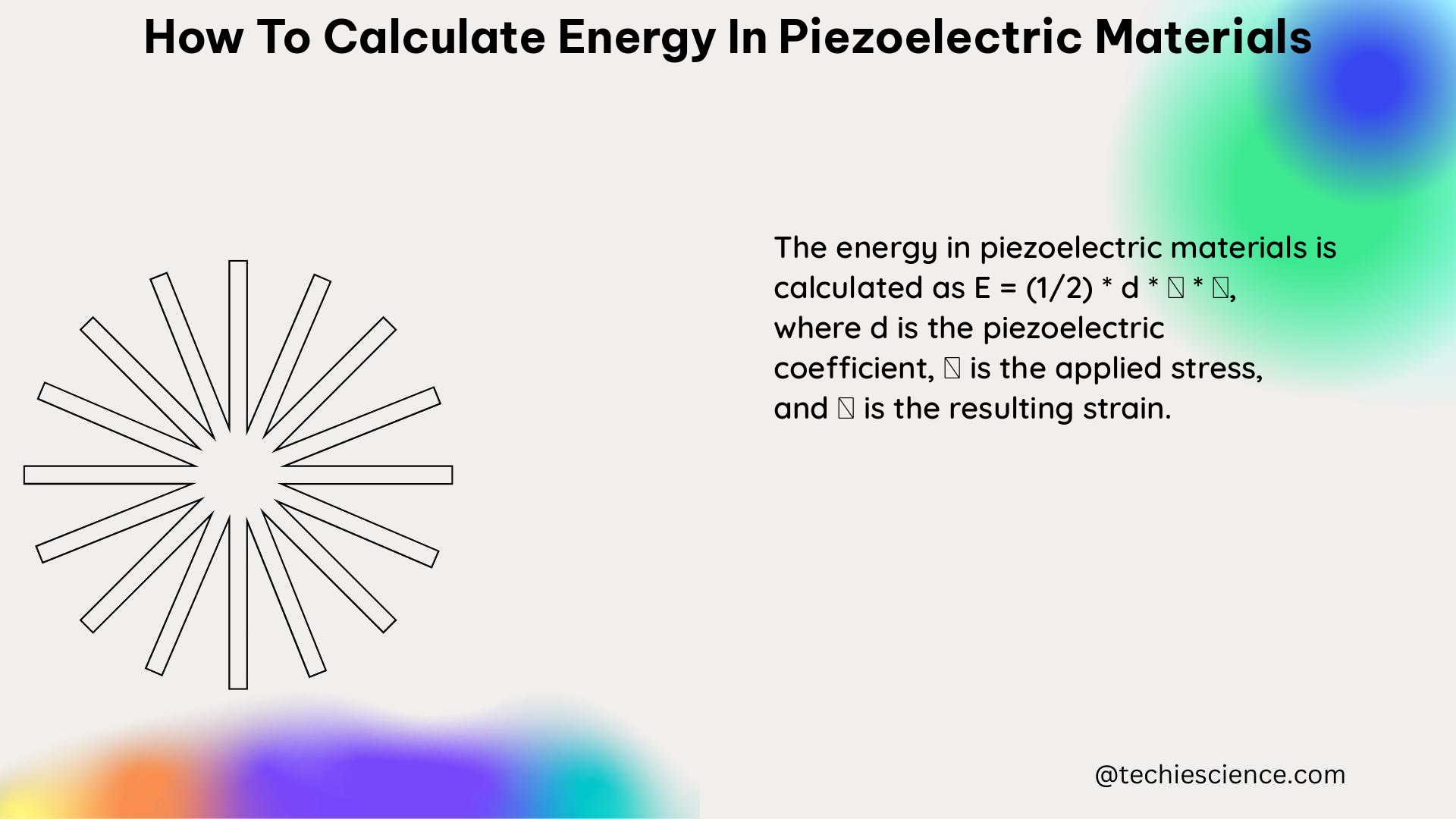Piezoelectric materials exhibit a unique property of converting mechanical energy into electrical energy and vice versa. To accurately calculate the energy in these materials, we need to consider several measurable and quantifiable parameters, including the piezoelectric strain coefficient, permittivity, compliance, and coupling coefficient. This comprehensive guide will provide you with the necessary equations, formulas, and examples to understand the energy calculations in piezoelectric materials.
Understanding the Piezoelectric Effect
The piezoelectric effect is a linear electromechanical interaction between the mechanical and electrical states of a material. This effect is described by two fundamental laws:
- Linear Electrical Behavior: The relationship between the electric charge density displacement (D), permittivity (ε), and electric field strength (E) is given by the equation: D = εE.
- Hooke’s Law for Elastic Materials: The relationship between strain (S), compliance (s), and stress (T) is given by the equation: S = sT.
These two laws can be combined into a coupled equation, known as the strain-charge form:
D = dT + εE
where d is the piezoelectric strain coefficient.
Piezoelectric Equations and Matrices

In practice, piezoelectric coefficients can be defined in four ways, leading to four different formats for the piezoelectric equations. For a material of the 4mm (C4v) crystal class, such as a poled piezoelectric ceramic, the strain-charge matrix relation is:
[S] = [d][T] + [ε][E]
where [S], [T], [E], and [D] are 6×1 matrices representing the strain, stress, electric field, and electric displacement, respectively, and [d] and [ε] are 6×6 matrices representing the piezoelectric strain coefficient and the permittivity, respectively.
Piezoelectric Material Parameters
To accurately model piezoelectric materials, we need 13 independent parameters:
- Density (ρ)
- 6 Stiffness (or Compliance) Components (c11, c12, c13, c33, c44, c66)
- 3 Piezoelectric Coefficients (d31, d33, g33)
- 2 Dielectric Constants (εT or εS: εxx and εzz)
Characterizing Piezoelectric Materials for Transducers
When characterizing piezoelectric materials for transducer applications, we need to consider the following properties:
- Piezoelectric Charge Constant (d): Measured in pC/N, it represents the charge generated per unit area of electrode per unit applied stress.
- Piezoelectric Voltage Constant (g): Measured in mV/N, it represents the voltage generated per unit applied stress.
- Relative Permittivity (εr): Measured dimensionless, it represents the dielectric constant of the material relative to that of free space.
- Elastic Compliance (s): Measured in m^2/N, it represents the strain per unit applied stress.
- Electromechanical Coupling Coefficient (k): Measured dimensionless, it represents the efficiency of the conversion of mechanical energy to electrical energy (or vice versa).
- Mechanical Quality Factor (Qm): Measured dimensionless, it represents the mechanical losses in the material.
- Dielectric Loss Tangent (tan δ): Measured dimensionless, it represents the dielectric losses in the material.
Energy Calculations in Piezoelectric Materials
The energy stored in a piezoelectric material can be calculated using the following equation:
E = 1/2 * D * E
where E is the energy, D is the electric displacement, and E is the electric field strength.
Substituting the strain-charge form equation, we can rewrite the energy equation as:
E = 1/2 * (dT + εE) * E
This equation can be further expanded and simplified based on the specific piezoelectric material properties and the application requirements.
Examples and Numerical Problems
Let’s consider a practical example to illustrate the energy calculations in piezoelectric materials.
Example: Suppose we have a poled piezoelectric ceramic with the following properties:
– Piezoelectric strain coefficient (d33) = 400 pC/N
– Relative permittivity (εr) = 1800
– Elastic compliance (s33) = 16.5 x 10^-12 m^2/N
– Applied stress (T) = 5 MPa
Calculate the energy stored in the piezoelectric material.
Solution:
1. Calculate the electric displacement (D):
D = dT = 400 pC/N * 5 MPa = 2 C/m^2
-
Calculate the electric field strength (E):
E = D / ε = 2 C/m^2 / (1800 * 8.854 x 10^-12 F/m) = 1.26 x 10^6 V/m -
Calculate the energy stored (E):
E = 1/2 * D * E = 1/2 * 2 C/m^2 * 1.26 x 10^6 V/m = 1.26 J/m^3
Therefore, the energy stored in the piezoelectric material is 1.26 J/m^3.
You can find more detailed examples and numerical problems in the references provided below.
Conclusion
Calculating the energy in piezoelectric materials requires a deep understanding of the underlying physics, material properties, and the specific application requirements. By following the equations, formulas, and examples provided in this guide, you can accurately determine the energy stored in piezoelectric materials and optimize their performance for various applications, such as sensors, actuators, and energy harvesting devices.
References
- Calculating Piezoelectric Material Properties from Material Datasheet – Onscale Support
- A New Method to Perform Direct Efficiency Measurement and Power Conversion of Piezoelectric Energy Harvesters – Sensors
- Piezoelectricity – ScienceDirect Topics
- Piezoelectricity – Wikipedia
- Characterization of Piezoelectric Materials for Transducers – arXiv

The lambdageeks.com Core SME Team is a group of experienced subject matter experts from diverse scientific and technical fields including Physics, Chemistry, Technology,Electronics & Electrical Engineering, Automotive, Mechanical Engineering. Our team collaborates to create high-quality, well-researched articles on a wide range of science and technology topics for the lambdageeks.com website.
All Our Senior SME are having more than 7 Years of experience in the respective fields . They are either Working Industry Professionals or assocaited With different Universities. Refer Our Authors Page to get to know About our Core SMEs.